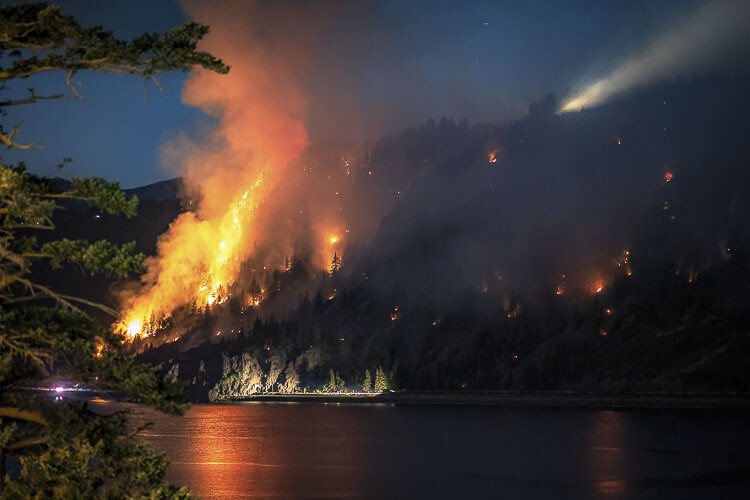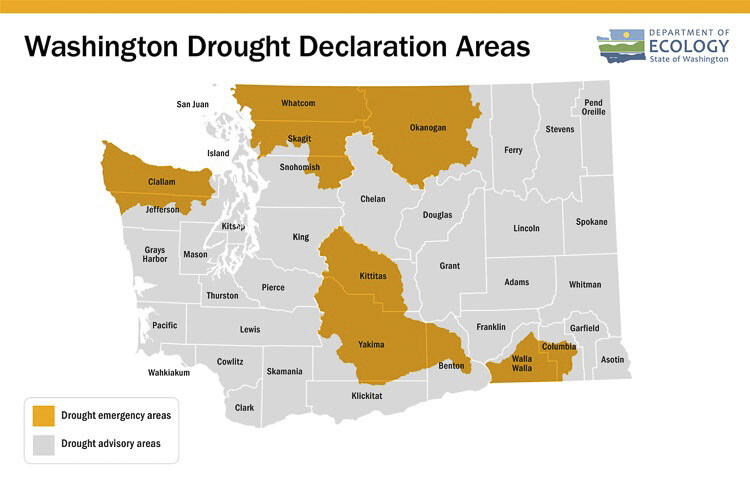
The announcement changes the classification of those counties from drought advisories to drought emergencies
Timothy Schumann
The Center Square Washington
With wildfire season in full swing in Washington, the Department of Ecology has issued a declaration covering 12 counties spanning west to east from Whatcom to Walla Walla.
The announcement Monday changes the classification of those counties, listed below, from drought advisories to drought emergencies, citing “early snowmelt, a lack of spring rain and low streamflows.”

The list of counties affected is as follows;
- Benton
- Clallam
- Columbia
- Jefferson
- Kittitas
- Klickitat
- Okanogan
- Skagit
- Snohomish
- Walla Walla
- Whatcom
- Yakima
A more detailed map of affected areas is available on the Department of Ecology’s website.
According to the Department of Ecology, drought emergencies are declared in Washington state when there is 75% or less than normal water supply, and there is an additional risk of hardship to communities.
Hardships such as “limits on water users with more junior water rights, difficulties with fish passage, and a need to truck in drinking water to residents” are already occurring in the counties listed in the declaration.
The declaration opens up legal avenues for granting emergency water rights permits as well as transfers of water rights to those in need.
Additionally, legislation passed earlier this spring makes $3 million in emergency drought relief funds available for disbursement in grant form to assist communities, irrigation districts, tribal governments, and other public entities facing hardships.
“This drought is already harming Washington communities, businesses and farms, and it’s another sign of the damage that climate change is causing to our state,” said Department of Ecology Director Laura Watson in a statement issued with the announcement. “Today’s drought declaration will help to rapidly deliver relief to these areas, but we need to also be taking steps to manage water wisely and prepare for a drier future.”
In the north, Nooksack Basin has three water systems currently operating on emergency status, and some wells have even gone dry.
On the western tip of the state, the Clallam County PUD is trucking in water due to low streamflow, with some areas such as Neah Bay placed on mandatory watering restrictions since mid-May.
In the eastern portion of the state covered by the Walla Walla basin, there have been reports that portions of the watershed have dried up completely, leading to crop losses.
Ria Berns, manager of the Department of Ecology’s Water Resources program, warns that what we’re seeing may be the new normal.
“Climate change is making warm, dry summers more frequent, and droughts more severe. What we’re seeing this year is likely a sign of things to come,” said Berns.
More information on drought preparedness for Washington residents is available on the Department of Ecology website.
This report was first published by The Center Square Washington.
Also read:
- Hundreds rally in Olympia against proposed tax increasesHundreds gathered in Olympia on Tax Day to protest a wide range of proposed tax hikes put forward by Democratic lawmakers in Washington state.
- Vancouver City Council urged to adopt seven changes to limit public campingClark County Matters is calling on Vancouver leaders to adopt seven ordinance changes that would limit public camping and address growing concerns about safety and livability.
- On ‘Tax Day,’ Senate Democrats propose billions more in tax increasesOn Tax Day, Washington Senate Democrats introduced new tax proposals totaling $12 billion, contrasting sharply with Senate Republicans’ no-new-taxes ‘$ave Washington’ budget proposal.
- Letter: ‘There will be consequences’Hazel Dell resident Bob Zak criticizes Democratic lawmakers for advancing ESSB 5181, arguing it undermines parental rights and defies biblical principles.
- Clark County Fire District 10 selects local firm to begin planning for replacement of the Amboy Fire StationClark County Fire District 10 has selected Aetta Architecture to begin planning a replacement for the Amboy Fire Station, first built in 1963 and no longer equipped to meet modern emergency response demands.
- Kitten finders, kitten keepers?Nomi Berger shares practical steps for what to do if you find a litter of kittens this spring, including how to assess their needs and connect with Furry Friends in Vancouver.
- PeaceHealth Southwest Medical Center seeks new members for Patient & Family Advisory CouncilPeaceHealth Southwest Medical Center is seeking new members for its Patient & Family Advisory Council to help improve patient care through direct community feedback.











